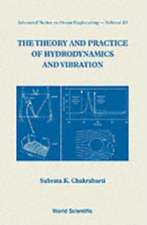Viability of Hybrid Systems: A Controllability Operator Approach: Intelligent Systems, Control and Automation: Science and Engineering, cartea 55
Autor G. Labinaz, M. Guayen Limba Engleză Paperback – 30 noi 2013
The theory is applied through simulation to an active magnetic bearing system and to a batch polymerization process showing that viability can be satisfied in practice. The problem of viable attainability is examined based on the controllability operator approach introduced by Nerode and colleagues. Lastly, properties of the controllability operator are presented.
| Toate formatele și edițiile | Preț | Express |
|---|---|---|
| Paperback (1) | 638.43 lei 6-8 săpt. | |
| SPRINGER NETHERLANDS – 30 noi 2013 | 638.43 lei 6-8 săpt. | |
| Hardback (1) | 640.06 lei 6-8 săpt. | |
| SPRINGER NETHERLANDS – 4 oct 2011 | 640.06 lei 6-8 săpt. |
Din seria Intelligent Systems, Control and Automation: Science and Engineering
- 18%
 Preț: 890.23 lei
Preț: 890.23 lei - 24%
 Preț: 672.02 lei
Preț: 672.02 lei - 18%
 Preț: 951.59 lei
Preț: 951.59 lei - 15%
 Preț: 647.27 lei
Preț: 647.27 lei - 15%
 Preț: 644.63 lei
Preț: 644.63 lei - 18%
 Preț: 1246.15 lei
Preț: 1246.15 lei - 18%
 Preț: 1011.45 lei
Preț: 1011.45 lei - 20%
 Preț: 752.69 lei
Preț: 752.69 lei - 18%
 Preț: 1230.66 lei
Preț: 1230.66 lei - 18%
 Preț: 1839.32 lei
Preț: 1839.32 lei - 18%
 Preț: 719.59 lei
Preț: 719.59 lei - 15%
 Preț: 636.12 lei
Preț: 636.12 lei - 18%
 Preț: 1112.15 lei
Preț: 1112.15 lei - 18%
 Preț: 1836.31 lei
Preț: 1836.31 lei - 18%
 Preț: 1236.51 lei
Preț: 1236.51 lei - 20%
 Preț: 988.81 lei
Preț: 988.81 lei - 20%
 Preț: 357.15 lei
Preț: 357.15 lei - 15%
 Preț: 640.71 lei
Preț: 640.71 lei - 18%
 Preț: 1835.83 lei
Preț: 1835.83 lei - 18%
 Preț: 947.98 lei
Preț: 947.98 lei - 18%
 Preț: 962.98 lei
Preț: 962.98 lei - 15%
 Preț: 643.48 lei
Preț: 643.48 lei - 18%
 Preț: 951.47 lei
Preț: 951.47 lei - 18%
 Preț: 950.84 lei
Preț: 950.84 lei - 20%
 Preț: 1924.47 lei
Preț: 1924.47 lei - 15%
 Preț: 644.30 lei
Preț: 644.30 lei - 20%
 Preț: 556.65 lei
Preț: 556.65 lei - 18%
 Preț: 952.72 lei
Preț: 952.72 lei - 18%
 Preț: 953.97 lei
Preț: 953.97 lei - 18%
 Preț: 951.14 lei
Preț: 951.14 lei
Preț: 638.43 lei
Preț vechi: 751.10 lei
-15% Nou
Puncte Express: 958
Preț estimativ în valută:
122.18€ • 132.67$ • 102.63£
122.18€ • 132.67$ • 102.63£
Carte tipărită la comandă
Livrare economică 22 aprilie-06 mai
Preluare comenzi: 021 569.72.76
Specificații
ISBN-13: 9789400737105
ISBN-10: 9400737106
Pagini: 256
Ilustrații: X, 246 p.
Dimensiuni: 155 x 235 x 13 mm
Greutate: 0.36 kg
Ediția:2012
Editura: SPRINGER NETHERLANDS
Colecția Springer
Seria Intelligent Systems, Control and Automation: Science and Engineering
Locul publicării:Dordrecht, Netherlands
ISBN-10: 9400737106
Pagini: 256
Ilustrații: X, 246 p.
Dimensiuni: 155 x 235 x 13 mm
Greutate: 0.36 kg
Ediția:2012
Editura: SPRINGER NETHERLANDS
Colecția Springer
Seria Intelligent Systems, Control and Automation: Science and Engineering
Locul publicării:Dordrecht, Netherlands
Public țintă
ResearchCuprins
1 Introduction.- 1.1 Motivation and History.- 1.2 Summary and Organization.- 1.3 Summary.- 2 Literature Review.- 2.1 Nerode et al Approach to Viability of Hybrid Systems [50],[71].- 2.2 Aubin et al Approach to Viability of Hybrid
Systems [15].- 2.3 Deshpande{Varaiya Approach to Viability of Hybrid Systems [35].- 2.4 Related Literature.- 2.5 Conclusion.- 3 Hybrid Model.- 3.1 Hybrid Phenomena and Hybrid Model.- 3.2 Hybrid Trajectories and their Ordering.- 3.3 Continuity, Fixed Points, and Correct Finite Control Automaton.- 3.4 Uncertainty in Hybrid Systems.- 3.5 The Three-Tank Problem.- 3.6 Nerode{Kohn Formalism for Hybrid Systems.- 3.7 Conclusion.- 4 Viability.- 4.1 Background.- 4.2 Time{Independent Viability Set.- 4.3 Fixed Point Approximation.- 4.4 Computation of TIC{COFPAA{I for Three Admissible Control Law Classes.- 4.4.1 Piecewise Constant Control.- 4.4.2 Piecewise Constant with Finite Switching.- 4.4.3 Piecewise Constant with Polynomial Control.- 4.5 Time{Dependent Viability Set.- 4.5.1 Piecewise Constant Control.- 4.6 Examples.- 4.6.1 Time{Independent Constraints.- 4.6.2 Time{Dependent Constraints.- 4.7 Conclusion.- 5 Robust Viability.- 5.1 Uncertainty and Robustness.- 5.2 Ordering of the Controllability Operatorunder Uncertainty.- 5.3 The Uncertain Controllability Operator and the Uncertainty Operator.- 5.4 Robust Viability.- 5.5 Robust Viability Control Design.- 5.6 Examples.- 5.7 Conclusion.- 6 Viability in Practice.- 6.1 Reachable Set Computation of the Controllability Operator.- 6.2 Viable Cascade Control and Application to a Batch Polymerization Process [55][56].- 6.2.1 Batch Polymerization Process Model.- 6.2.2 Hybrid Model.- 6.2.3 Viable Cascade Control.- 6.2.4 Batch Polymerization Control.- 6.2.5 Discussion and Conclusions.- 6.2.6 Appendix.- 6.3 Conclusion.- 7 An Operator Approach to Viable Attainability of Hybrid Systems [60].- 7.1 Introduction.- 7.2 Attainability and the Attainability Operator.- 7.3 Viable Attainability and the Viable Attainability Operator.- 7.4 Simulation Examples.- 7.5 Conclusion.- 8 Some Topics Related to the Controllability Operator.- 8.1 Topological Continuity Arising from Fixed Point Approximation Algorithm.- 8.2 The Lattice over Control Laws of the Controllability Operator.- 8.3 Homotopic Approximation under PWC_.- k.- PWCPC_.- k.- 8.4 Conclusion.- 9 Conclusions.- References.
Systems [15].- 2.3 Deshpande{Varaiya Approach to Viability of Hybrid Systems [35].- 2.4 Related Literature.- 2.5 Conclusion.- 3 Hybrid Model.- 3.1 Hybrid Phenomena and Hybrid Model.- 3.2 Hybrid Trajectories and their Ordering.- 3.3 Continuity, Fixed Points, and Correct Finite Control Automaton.- 3.4 Uncertainty in Hybrid Systems.- 3.5 The Three-Tank Problem.- 3.6 Nerode{Kohn Formalism for Hybrid Systems.- 3.7 Conclusion.- 4 Viability.- 4.1 Background.- 4.2 Time{Independent Viability Set.- 4.3 Fixed Point Approximation.- 4.4 Computation of TIC{COFPAA{I for Three Admissible Control Law Classes.- 4.4.1 Piecewise Constant Control.- 4.4.2 Piecewise Constant with Finite Switching.- 4.4.3 Piecewise Constant with Polynomial Control.- 4.5 Time{Dependent Viability Set.- 4.5.1 Piecewise Constant Control.- 4.6 Examples.- 4.6.1 Time{Independent Constraints.- 4.6.2 Time{Dependent Constraints.- 4.7 Conclusion.- 5 Robust Viability.- 5.1 Uncertainty and Robustness.- 5.2 Ordering of the Controllability Operatorunder Uncertainty.- 5.3 The Uncertain Controllability Operator and the Uncertainty Operator.- 5.4 Robust Viability.- 5.5 Robust Viability Control Design.- 5.6 Examples.- 5.7 Conclusion.- 6 Viability in Practice.- 6.1 Reachable Set Computation of the Controllability Operator.- 6.2 Viable Cascade Control and Application to a Batch Polymerization Process [55][56].- 6.2.1 Batch Polymerization Process Model.- 6.2.2 Hybrid Model.- 6.2.3 Viable Cascade Control.- 6.2.4 Batch Polymerization Control.- 6.2.5 Discussion and Conclusions.- 6.2.6 Appendix.- 6.3 Conclusion.- 7 An Operator Approach to Viable Attainability of Hybrid Systems [60].- 7.1 Introduction.- 7.2 Attainability and the Attainability Operator.- 7.3 Viable Attainability and the Viable Attainability Operator.- 7.4 Simulation Examples.- 7.5 Conclusion.- 8 Some Topics Related to the Controllability Operator.- 8.1 Topological Continuity Arising from Fixed Point Approximation Algorithm.- 8.2 The Lattice over Control Laws of the Controllability Operator.- 8.3 Homotopic Approximation under PWC_.- k.- PWCPC_.- k.- 8.4 Conclusion.- 9 Conclusions.- References.
Recenzii
From the reviews:
“This book considers hybrid systems with uncertainties and state constraints. … it provides an interesting approach to viability problems with uncertainties and it explains the relations to other concepts of hybrid systems very well. … I recommend that the reader focus on the key notions behind each step of conceptual or algorithmic extension. … this book will provide interesting new insights into the broad field of hybrid systems.” (Thomas Lorenz, Mathematical Reviews, January, 2013)
“This book considers hybrid systems with uncertainties and state constraints. … it provides an interesting approach to viability problems with uncertainties and it explains the relations to other concepts of hybrid systems very well. … I recommend that the reader focus on the key notions behind each step of conceptual or algorithmic extension. … this book will provide interesting new insights into the broad field of hybrid systems.” (Thomas Lorenz, Mathematical Reviews, January, 2013)
Textul de pe ultima copertă
The problem of viability of hybrid systems is considered in this work. A model for a hybrid system is developed including a means of including three forms of uncertainty: transition dynamics, structural uncertainty, and parametric uncertainty. A computational basis for viability of hybrid systems is developed and applied to three control law classes. An approach is developed for robust viability based on two extensions of the controllability operator. The three-tank example is examined for both the viability problem and robust viability problem.
The theory is applied through simulation to an active magnetic bearing system and to a
batch polymerization process showing that viability can be satisfied in practice. The problem of viable attainability is examined based on the controllability operator approach introduced by Nerode and colleagues. Lastly, properties of the controllability operator are presented.
The theory is applied through simulation to an active magnetic bearing system and to a
batch polymerization process showing that viability can be satisfied in practice. The problem of viable attainability is examined based on the controllability operator approach introduced by Nerode and colleagues. Lastly, properties of the controllability operator are presented.
Caracteristici
Examines viability of hybrid systems from a controllability operator perspective Provides a complete modelling formalism including addressing existence of solution and continuity of the closed-loop system Solves the three-tank problem in different contexts Provides a unified formalism for robust viability Includes supplementary material: sn.pub/extras














